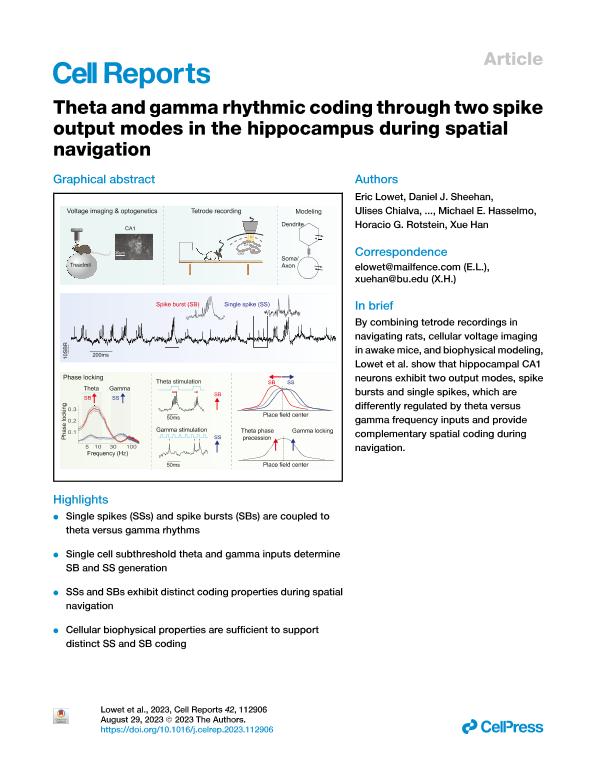Artículo
Theta and gamma rhythmic coding through two spike output modes in the hippocampus during spatial navigation
Lowet, Eric; Sheehan, Daniel J.; Chialva, Ulises ; De Oliveira Pena, Rodrigo; Mount, Rebecca A.; Xiao, Sheng; Zhou, Samuel L.; Tseng, Hua-an; Gritton, Howard; Shroff, Sanaya; Kondabolu, Krishnakanth; Cheung, Cyrus; Wang, Yangyang; Piatkevich, Kiryl D.; Boyden, Edward S.; Mertz, Jerome; Hasselmo, Michael E.; Rotstein, Horacio; Han, Xue
; De Oliveira Pena, Rodrigo; Mount, Rebecca A.; Xiao, Sheng; Zhou, Samuel L.; Tseng, Hua-an; Gritton, Howard; Shroff, Sanaya; Kondabolu, Krishnakanth; Cheung, Cyrus; Wang, Yangyang; Piatkevich, Kiryl D.; Boyden, Edward S.; Mertz, Jerome; Hasselmo, Michael E.; Rotstein, Horacio; Han, Xue
 ; De Oliveira Pena, Rodrigo; Mount, Rebecca A.; Xiao, Sheng; Zhou, Samuel L.; Tseng, Hua-an; Gritton, Howard; Shroff, Sanaya; Kondabolu, Krishnakanth; Cheung, Cyrus; Wang, Yangyang; Piatkevich, Kiryl D.; Boyden, Edward S.; Mertz, Jerome; Hasselmo, Michael E.; Rotstein, Horacio; Han, Xue
; De Oliveira Pena, Rodrigo; Mount, Rebecca A.; Xiao, Sheng; Zhou, Samuel L.; Tseng, Hua-an; Gritton, Howard; Shroff, Sanaya; Kondabolu, Krishnakanth; Cheung, Cyrus; Wang, Yangyang; Piatkevich, Kiryl D.; Boyden, Edward S.; Mertz, Jerome; Hasselmo, Michael E.; Rotstein, Horacio; Han, Xue
Fecha de publicación:
08/2023
Editorial:
Cell Press
Revista:
Cell Reports
e-ISSN:
2211-1247
Idioma:
Inglés
Tipo de recurso:
Artículo publicado
Clasificación temática:
Resumen
Hippocampal CA1 neurons generate single spikes and stereotyped bursts of spikes. However, it is unclear how individual neurons dynamically switch between these output modes and whether these two spiking outputs relay distinct information. We performed extracellular recordings in spatially navigating rats and cellular voltage imaging and optogenetics in awake mice. We found that spike bursts are preferentially linked to cellular and network theta rhythms (3–12 Hz) and encode an animal's position via theta phase precession, particularly as animals are entering a place field. In contrast, single spikes exhibit additional coupling to gamma rhythms (30–100 Hz), particularly as animals leave a place field. Biophysical modeling suggests that intracellular properties alone are sufficient to explain the observed input frequency-dependent spike coding. Thus, hippocampal neurons regulate the generation of bursts and single spikes according to frequency-specific network and intracellular dynamics, suggesting that these spiking modes perform distinct computations to support spatial behavior.
Archivos asociados
Licencia
Identificadores
Colecciones
Articulos(CCT - BAHIA BLANCA)
Articulos de CTRO.CIENTIFICO TECNOL.CONICET - BAHIA BLANCA
Articulos de CTRO.CIENTIFICO TECNOL.CONICET - BAHIA BLANCA
Citación
Lowet, Eric; Sheehan, Daniel J.; Chialva, Ulises; De Oliveira Pena, Rodrigo; Mount, Rebecca A.; et al.; Theta and gamma rhythmic coding through two spike output modes in the hippocampus during spatial navigation; Cell Press; Cell Reports; 42; 8; 8-2023; 1-24
Compartir
Altmétricas



